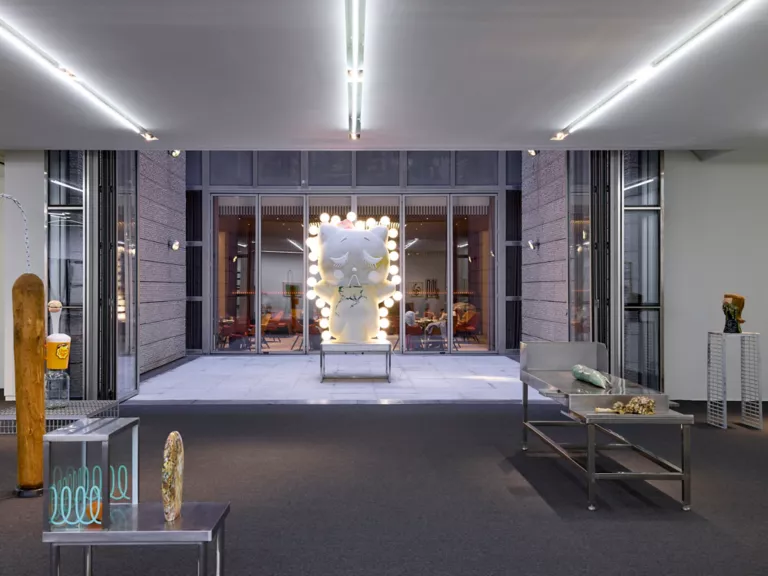Artists don’t always work in their studios. As artists experiment with new ideas and look at today’s world with new ways of seeing, it has never been more important for artists to interact with others in various social and cultural environments.
One of the programs that offers artists this kind of opportunity is the artist residency program. Through the program, artists can be in a new environment that is different from their usual workspaces for a certain period of time. With new experiences, various networking takes place, and, depending on the program, other support, such as workshops and exhibition opportunities, is provided.
For artists, participating in residency programs has become just as important to their careers as holding an exhibition or winning an award. As residency programs exist in various places around the world, their forms vary greatly depending on the location, the provided programs, and the participation period.

MMCA's Changdong Residency, Seoul. ⓒ MMCA.
It was a globalization that accelerated the spread of artist residency programs across the borders in the 1990s. As the world became interconnected through cross-border trade in knowledge and ideas, alternative programs with diversified residency models emerged. There has been a significant increase worldwide in the number of artist-in-residence programs that are locally based, focus on certain themes, and offer various workshops and collaborations.
 The Gwangju Museum of Art's Palgakjeong Studio. From 1995-2011. ⓒ Gwangju Museum of Art.
The Gwangju Museum of Art's Palgakjeong Studio. From 1995-2011. ⓒ Gwangju Museum of Art.In South Korea, the artist residency program first appeared during the 1990s. There was a need to revive the Korean art scene in line with the global trend, especially as the Korean art scene deteriorated with the economic downturn in the late 1990s. One of the first residency programs was initiated in 1995 at the Palgakjeong Studio operated by the Gwangju Museum of Art.
In 1998, Korea’s Ministry of Culture, Sports, and Tourism announced a master plan for the expansion of artist studios and residency programs. As significant government support was offered to initiate such facilities and programs, the number of artist residencies in Korea started to grow in the 2000s, especially after the Changdong Residency by the National Museum of Modern and Contemporary Art, Korea (MMCA), was opened in a closed school building in 2002.
The number of these programs reached about forty in 2005, and, according to the Korea Culture & Tourism Institute, the number tripled to 124 in 2013. Now, there is a vast array artist residency programs run by public and private institutions throughout Korea.
While there are many artist residency programs in the country, here are the three main artist residency programs operated by public art institutions; MMCA’s Changdong Residency & Goyang Residency, SeMA’s Nanji Residency, and Asian Culture Center’s ACC_R.

MMCA's Goyang Residency, Gyeonggi-do. ⓒ MMCA.
MMCA’s Changdong Residency & Goyang Residency
MMCA’s Changdong Residency was opened in 2002, and the Goyang Residency opened in 2004. They are located in Chang-dong, Seoul, and in Goyang, Gyeonggi-do, respectively. The MMCA’s residency program aims to promote Korean contemporary art to the international art world and expand networking opportunities for artists. To follow this mission, the MMCA supports artists by offering improved studio spaces and providing opportunities to network with artists of different backgrounds.
Both residency programs provide studio space, various programs, and opportunities to participate in exhibitions during their twelve-month residence. The program is open to all artists, regardless of nationality, but each program has different requirements. For the Changdong Residency, any artists over forty who work in the fields of arts and culture, including visual arts, literature, music, and film criticism, are eligible to apply. The Goyang Residency accepts artists under the age of twenty-five who work in the field of contemporary visual art.

SeMA’s Nanji Residency. ⓒ SeMA
SeMA’s Nanji Residency
SeMA’s Nanji Residency opened its door in 2006 after renovating a shut-down facility in Nanji Hangang Park. The program aims to cultivate the Korean contemporary art scene by providing various opportunities for Korean contemporary artists and researchers over twelve months.
Until 2009, the program focused on supporting young Korean artists by providing studio spaces. Since 2010, the museum has expanded and diversified its program to provide various opportunities, such as exhibitions, research projects, and networking opportunities. Since 2012, the opportunity to participate in overseas residencies for up to three months is given to selected Korean artists.

Asian Culture Center 's ACC_R. ⓒ ACC
Asian Culture Center ‘s ACC_R
The ACC_R, or the Asian Culture Center Residency, started in 2015 under the center’s mission to expand the cultural and artistic diversity of Asia and function as research, creation, and production platform.
The ACC_R consists of ten fields centered on creation and production, research, and institutional cooperation, and each field has different requirements and different duration. The ACC_R is open to all artists and researchers, regardless of nationality. The program supports artists with facilities, programs, and various networking opportunities.
















